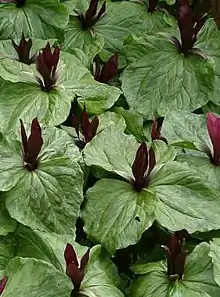Trillium chloropetalum
Trillium chloropetalum, also known as giant trillium,[3] giant wakerobin,[4] or common trillium,[5] is a species of flowering plant in the family Melanthiaceae. It is found in the coast ranges of California and the Sierra Nevada foothills, from Siskiyou County to Santa Barbara and Madera Counties.[6]
| Trillium chloropetalum | |
|---|---|
 | |
| Scientific classification | |
| Kingdom: | Plantae |
| Clade: | Tracheophytes |
| Clade: | Angiosperms |
| Clade: | Monocots |
| Order: | Liliales |
| Family: | Melanthiaceae |
| Genus: | Trillium |
| Species: | T. chloropetalum |
| Binomial name | |
| Trillium chloropetalum | |
| Synonyms[2] | |
|
Synonymy
| |
Trillium chloropetalum is a perennial herbaceous plant that blooms from late February to early or mid April. The petal color is variable, from dark red to white. Like other Trillium species the leaves and flowers are grouped in threes. It is clump-forming and prefers a shady woodland habitat.[3]
Taxonomy
Two infraspecific names are accepted:
- Trillium chloropetalum var. chloropetalum[7]
- Trillium chloropetalum var. giganteum (Hook. & Arn.) Munz[8]
The petals of T. chloropetalum var. chloropetalum always show yellow pigments, which are often masked with purple or other pigments.[9] In contrast, the petals of T. chloropetalum var. giganteum lack yellow pigments.[10] The latter variety, with its deep maroon flower petals, has gained the Royal Horticultural Society’s Award of Garden Merit.[11][12]
In the San Francisco Bay Area, a white-petaled form of T. chloropetalum var. giganteum is often confused with T. albidum, which also has white petals. The former is distinguished by the purple pigment in its anthers, a character lacking in T. albidum.[13]
Bibliography
- Case, Frederick W.; Case, Roberta B. (1997). Trilliums. Portland, Oregon: Timber Press. ISBN 978-0-88192-374-2.
- Freeman, J. D. (1975). "Revision of Trillium subgenus Phyllantherum (Liliaceae)". Brittonia. 27 (1): 1–62. doi:10.2307/2805646. JSTOR 2805646. S2CID 20824379.
![]() Media related to Trillium chloropetalum at Wikimedia Commons
Media related to Trillium chloropetalum at Wikimedia Commons
References
- "Trillium chloropetalum". NatureServe Explorer. NatureServe. Retrieved 2008-05-02.
- "Trillium stamineum". World Checklist of Selected Plant Families (WCSP). Royal Botanic Gardens, Kew.
- Case Jr., Frederick W. (2002). "Trillium chloropetalum". In Flora of North America Editorial Committee (ed.). Flora of North America North of Mexico (FNA). 26. New York and Oxford – via eFloras.org, Missouri Botanical Garden, St. Louis, MO & Harvard University Herbaria, Cambridge, MA.
- "Trillium chloropetalum". Natural Resources Conservation Service PLANTS Database. USDA. Retrieved 15 December 2015.
- "Trillium chloropetalum". Calflora: Information on California plants for education, research and conservation, with data contributed by public and private institutions and individuals, including the Consortium of California Herbaria. Berkeley, California: The Calflora Database – via www.calflora.org.
- "Trillium chloropetalum". County-level distribution map from the North American Plant Atlas (NAPA). Biota of North America Program (BONAP). 2014. Retrieved 7 October 2019.
- "Trillium chloropetalum var. chloropetalum". World Checklist of Selected Plant Families (WCSP). Royal Botanic Gardens, Kew.
- "Trillium chloropetalum var. giganteum". World Checklist of Selected Plant Families (WCSP). Royal Botanic Gardens, Kew.
- Case Jr., Frederick W. (2002). "Trillium chloropetalum var. chloropetalum". In Flora of North America Editorial Committee (ed.). Flora of North America North of Mexico (FNA). 26. New York and Oxford – via eFloras.org, Missouri Botanical Garden, St. Louis, MO & Harvard University Herbaria, Cambridge, MA.
- Case Jr., Frederick W. (2002). "Trillium chloropetalum var. giganteum". In Flora of North America Editorial Committee (ed.). Flora of North America North of Mexico (FNA). 26. New York and Oxford – via eFloras.org, Missouri Botanical Garden, St. Louis, MO & Harvard University Herbaria, Cambridge, MA.
- "RHS Plantfinder - Trillium chloropetalum var. giganteum". Retrieved 24 December 2018.
- "AGM Plants - Ornamental" (PDF). Royal Horticultural Society. July 2017. p. 102. Retrieved 24 December 2018.
- Freeman (1975), p. 51.
External links
- Calflora Database: Trillium chloropetalum (Giant wakerobin)
- Jepson eFlora (TJM2) treatment of Trillium chloropetalum — Jepson Manual Online.
- Biodiversity Information Serving Our Nation (BISON) occurrence data and maps for Trillium chloropetalum
- Biodiversity Information Serving Our Nation (BISON) occurrence data and maps for Trillium chloropetalum var. chloropetalum
- Biodiversity Information Serving Our Nation (BISON) occurrence data and maps for Trillium chloropetalum var. giganteum
- Citizen science observations for Trillium chloropetalum at iNaturalist
